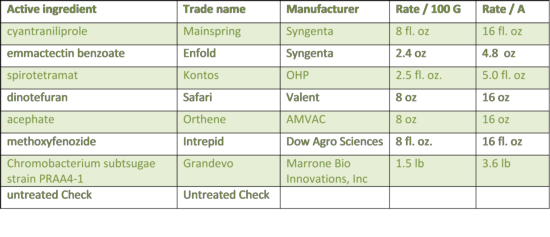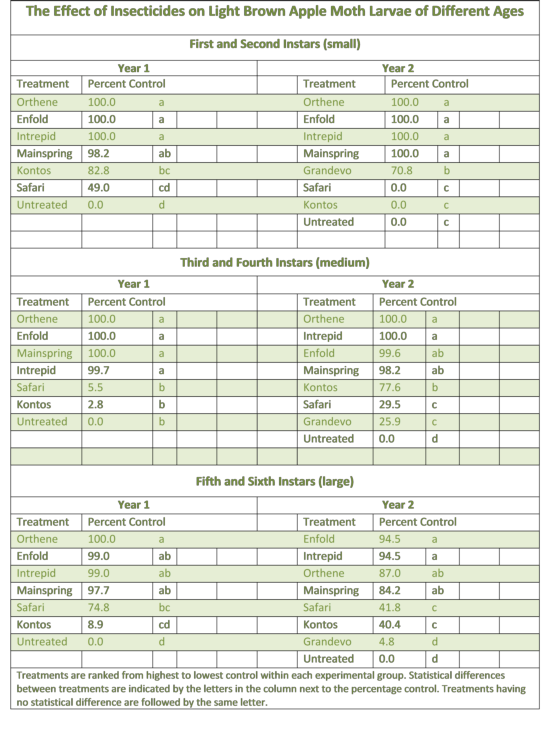Fall 2014: Effect of Insecticides on Light Brown Apple Moth Larvae of Different Ages
Regional Report for Santa Cruz and Monterey Counties by Steve Tjosvold
The light brown apple moth (LBAM) is an important quarantine pest of nursery crops and other agricultural commodities in California. Because LBAM has a large host range, the nursery crops trade can be a high-risk pathway for moving the pest to new locations. The overall goal of this research was to evaluate the efficacy of various insecticides on LBAM larvae on a typical nursery crop under field conditions. Since older larvae are more robust and are usually sheltered in leaf rolls, we evaluated insecticides with various capabilities of plant systemic activity that might help control these larvae.
Established Pacific wax myrtle in 1-gallon pots were infested with five LBAM egg masses and covered in an insect-rearing sleeve to contain all life stages on each plant. LBAM development was monitored by making weekly field observations and periodically larvae were sampled and the head-capsule size was measured to establish their age. (First instars are those larvae that have just emerged from eggs; fifth or sixth instars are the oldest larval stages and can develop into pupae.) All infested plants were divided into three sets of plants and each set was treated with insecticides when it contained larvae of a given age: (1) first and second instars, (2) third and fourth instars and (3) fifth and sixth instars. Plants were laid out in a split-plot experimental design in screened field cages. The three sets were grouped as main plots and insecticide treatments were sub-plots with five plant replications. Applications were made in year 1 on 18 July, 6 Aug, and 16 Aug 2013 and the entire experiment was repeated in year 2 on 25 Nov 2013, 11 Feb and 4 Mar 2014. All treated plants were observed weekly. When mostly adults were present, the plants were harvested and all surviving larvae, pupae, and moths were separated and counted.

Insecticide treatments consisted of the highest labeled rate (for registered products) and included a surfactant (Dyn-Amic, 3 pints/100 G) in insecticide treatments and untreated check treatment. Year 2 included a new treatment (Grandevo). All products were registered for ornamental use in California except for Enfold and Mainspring. All spray applications were made by hand with a carbon dioxide sprayer at constant pressure with a single TeeJet 8002 flat-fan nozzle to groups of plants spaced as they would be in a commercial nursery. The spray was directed at upper-and-lower leaf surfaces and provided thorough leaf coverage at a rate of 200 gallons per acre.
Results are given in the table below as percent control relative to the untreated check. (The total number of surviving life forms counted on each treated plant was used as the determinant of the percentage control; 100% indicated no life forms survived the treatment). In general, Orthene, Enfold, Intrepid and Mainspring were the most effective on all larval stages. Safari and Kontos provided some, but inconsistent, control on all larval stages. Grandevo, a new bacterial toxin and organically registered, provided moderate control of young larvae, although this was tested in only one of the two years.

Two products (Orthene and Mainspring) were highly effective because they have activity against the target pest and are highly systemic and moving readily in the plant to contact all larval stages. Orthene, a broad-spectrum organphosphate insecticide and long-standing product in the ornamental market, was highly effective on all larval stages, including the larger larvae that were sheltered in leaf rolls. Mainspring, a new diamide insecticide that is primarily active on moth larvae, was also highly effective on all larval stages.
Two products (Kontos and Safari), although highly systemic, are not known for activity on moth larvae. Therefore the inconsistent low-to-moderate control was not so surprising.
Two products (Enfold and Intrepid) have activity against the target pest but are only locally systemic (moving within the leaves). However, these products were highly effective. Enfold is an avermectin (similar to the long-standing Avid) and is currently being considered for registration in ornamental crops. Intrepid is an insect growth regulator targeting moth larvae. Previous research showed that Intrepid has very good efficacy and long residual activity (3 to 4 weeks) when applied before or after eggs are deposited by LBAM moths. This research demonstrates additional activity on all larval stages. Because of its inherent selectivity and safety to beneficial insects (and the fact that it is currently registered), Intrepid could have a good fit into an integrated pest management strategy in nurseries.
Steven A. Tjosvold
Farm Advisor, Environmental Horticulture
UC Cooperative Extension Santa Cruz County
1432 Freedom Boulevard
Watsonville, CA 95076-2796
(831)763-8013 phone, (831) 763-8006 fax
satjosvold@ucanr.edu
http://cesantacruz.ucanr.edu/












